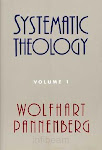1 week ago
Saturday, 19 April 2008
Theology of Art, Part II (continued)
Theology of Art, Part I
Hands and Brains (or Lack of)
Hands and Brains (or Lack of) (continued)
Theology of Art, Part II
The Body - Neither Puritanism nor Pornography
The Body - Neither Puritanism nor Pornography (continued)
Theology of Art, Part III
Nakedness and imago Dei
Nakedness and imago Dei (continued)
- - - - - - - - - - - - - - - - - - - - -
The Body - Neither Puritanism nor Pornography
(continued)
According to a trendy anti-Christian myth, the Original Sin had something to do with sexuality. The Church Fathers, on the contrary, taught that if it were not for man's fallenness, sexual pleasure would be more intense, enjoyable, and beautiful than it is today.
However, we do find the odd Church Father here and there whose writings include anti-sexual footnotes. The fresco example above also shows that not all Christian leaders have shared John Paul II's "positive" theology of the body. Within the pro-body Christian tradition, both on the level of doctrine and practice, quite a few suspicious eyes have judged the body. The suspicion is grounded in a partial truth that has been exaggerated at the expense of the whole truth. Man is fallen: the consequences of the fall echo in the human body - as well.
In the beginning, we noted that when one teaches the middle way - or truth - it is probable that distortions of both defect and excess will occur. The negative (defective or "suspicious") distortion was mentioned above, and can be called Manichaeism as regards the body in general and Puritanism as regards sexuality in particular.
An important question arises: How about the opposite extreme, the "worship" of the body and of sexuality?
It would have to be some kind of ideological materialism as regards the body in general and pornography as regards sexuality in particular. But do these - materialism and pornography - appear in Christianity at all?
Materialism and pornography are surely secularism's cousins, and pornographic currents can be detected especially in Eastern art and religion. But it is strange if - and seemingly that - these distortions seem to be lacking from the history of Christianity. At least they're hard to locate.
If, as noted, teaching the truth will (necessarily) invite distortions of both extremes, and Christianity claims to be the truth - yet lacks one of these extremes as regards the body and sexuality - how do we explain it? The question is perhaps ill-formed, certainly paradoxical, but nonetheless seems to be justified: "Where's the problem?"
(end of part II)
Subscribe to:
Post Comments (Atom)







No comments:
Post a Comment